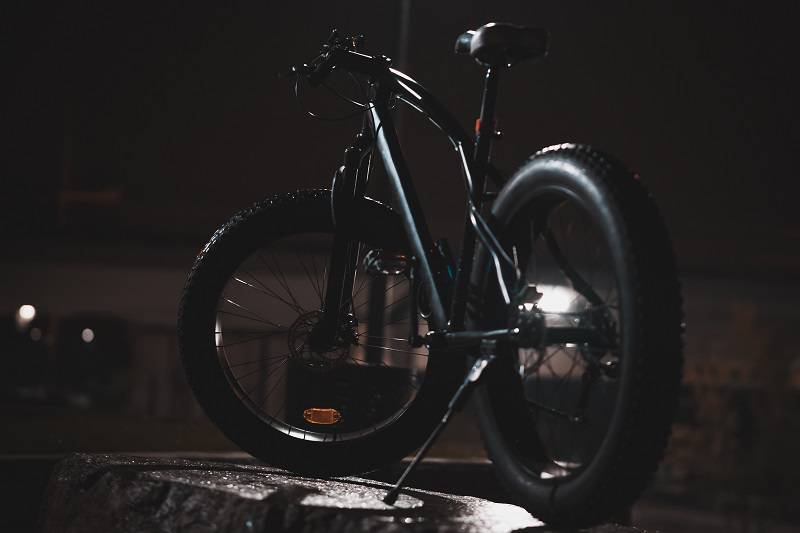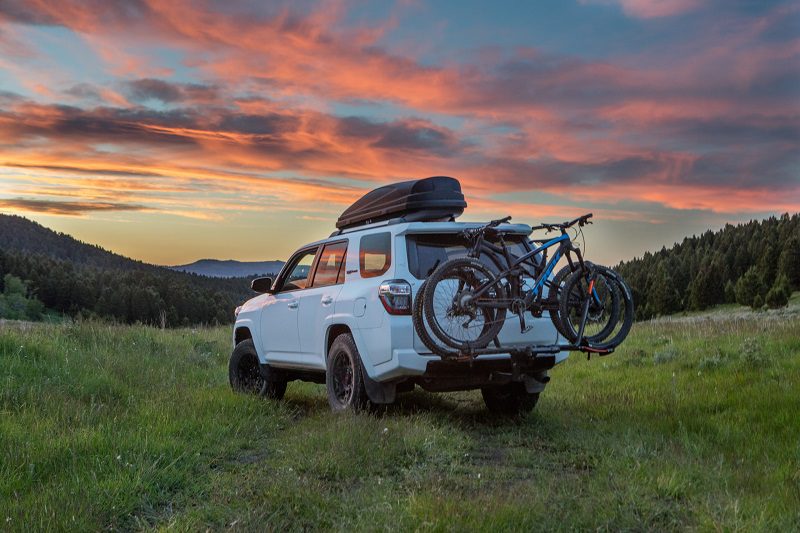
Full-suspension mountain bikes are marvels of engineering, designed with complex linkages and sensitive components to smooth out the roughest trails and provide unparalleled control. These advanced machines, often featuring carbon fiber frames and intricate geometries, represent a significant investment for any serious rider. Transporting them safely, especially with an SUV to reach those epic trailheads, requires more than just any bike rack; it demands a solution that prioritizes frame protection, stability, and compatibility with modern MTB designs.
This 2025 guide is for SUV owners who understand the value of their “squishy” bikes and are looking for truly “excellent” ways to carry them. We’ll explore why full-suspension MTBs have unique transport needs, why hitch-mounted, no-frame-contact platform racks are the undisputed champions for these bikes, detail the critical features to look for, and showcase top-tier racks designed to get your bike to the trail and back, ready to perform. For a general idea of gear you might need for mountain biking, REI offers a helpful checklist.
Why Your Full-Suspension MTB Deserves a Frame-Safe Ride (Especially on an SUV)
The very features that make your full-suspension mountain bike a dream on the trails can make it a nightmare on the wrong rack:
- Complex Frame Shapes & Sensitive Components: Full-suspension frames often have non-traditional tube shapes, external cable routing, and critical suspension pivot points. Clamping directly onto these frames, as many older or hanging-style racks do, can lead to cosmetic damage (scratches, cable rub) or, worse, structural damage, especially to carbon fiber frames.
- The No-Frame Contact Imperative: The gold standard for transporting any high-end bike, especially a full-suspension MTB, is a rack that makes NO contact with the frame. These racks secure the bike by its wheels or tires using arms, hooks, or trays, completely avoiding pressure on the frame. This is crucial for protecting carbon frames, preserving paint, and preventing undue stress on linkages and shock mounts.
- Weight & Stability: While a traditional full-suspension MTB might weigh around 29-37 lbs, the rise of full-suspension electric mountain bikes (e-MTBs) means racks often need to support bikes weighing 50-70 lbs or more. Regardless of weight, stability is key. A robust rack with a solid anti-wobble system is essential for SUV transport, especially when navigating unpaved roads to trail access points.
- Modern MTB Dimensions: Today’s full-suspension bikes feature wider tires (typically 2.3″ to 2.8″, with some “plus” bikes going wider), common wheel sizes like 27.5″ and 29″, and increasingly longer wheelbases. An “excellent” rack must accommodate these dimensions.
- SUV Considerations: Hitch-mounted racks are generally preferred for SUVs due to ease of loading heavier bikes compared to roof racks, and their ability to handle greater weight capacities. However, rear cargo access is a must, so tilt-down or swing-away features are highly valued.
Platform vs. Other Rack Styles for Full-Suspension MTBs: Platform is King
Platform Hitch Racks (Highly Recommended): These racks support bikes by their wheels in trays or cradles.
- Pros for Full-Suspension: Best for stability, easiest loading (especially for heavier bikes), ideal for no-frame contact designs, highly compatible with diverse frame geometries and suspension layouts.
- Cons: Can be heavier and more expensive than other types.
Hanging Hitch Racks (Generally NOT Recommended): These suspend bikes by the top tube.
- Pros: Lighter, sometimes more budget-friendly.
- Cons for Full-Suspension: Significant frame compatibility issues with complex MTB top tubes and shock placements, risk of bike-to-bike and bike-to-rack contact, potential for frame stress (very bad for carbon), often require top-tube adapters which can still be problematic.
Roof Racks (Viable, with Caveats):
- Pros: Can offer no-frame contact (e.g., Thule UpRide ). Keeps hitch free.
- Cons for Full-Suspension on SUVs: Lifting a potentially heavy full-suspension MTB onto an SUV roof can be challenging and risky. Wind resistance and overhead clearance are also concerns.

Top 5 Excellent Hitch Racks for Full-Suspension Mountain Bikes on SUVs (2025 Reviews)
Our top picks prioritize no-frame contact designs, stability, and features ideal for full-suspension MTBs and SUV utility:
| Feature | Thule T2 Pro XTR | Kuat NV 2.0 | RockyMounts Backstage | Yakima HoldUp EVO | Kuat Transfer V2 |
|---|---|---|---|---|---|
| Primary Benefit | Ultimate Stability & Versatility | Premium Design & Features | Unmatched SUV Access (Swing-Away) | Proven No-Frame Contact | Value No-Frame Contact |
| Frame Contact? | No (Front Wheel Arm) | No (Front Tire Cradle) | No (Front Wheel Hook) | No (StrongArm Wheel Hold) | No (Secures by Tires) |
| Wt. Cap. / Bike | 60 lbs | 60 lbs | 60 lbs | ~50 lbs (Verify e-MTB use) | ~40 lbs (Verify e-MTB use) |
| Max Tire Width | 5" | Up to 5" (w/ kit) | 5" | ~4.8" (Verify specific model) | 5" |
| Max Wheelbase | ~50" | ~48-50" | ~49" | Good for modern MTBs | ~50" |
| SUV Rear Access | Tilt-Down | Tilt-Down (Foot Assist) | 180° Swing-Away + Tilt | Tilt-Down | Tilt-Down |
1.Thule T2 Pro XTR
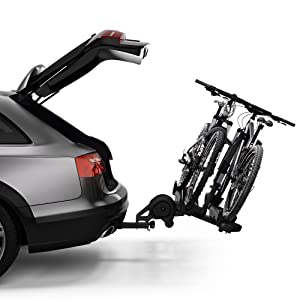
-
- Why It’s Excellent: A benchmark for premium platform racks, offering exceptional stability, ease of use, and zero frame contact. It’s versatile enough for various bike types, including heavy e-MTBs.
- Key Specs: No-frame contact (ratcheting arm over front wheel), 60 lbs/bike, fits tires up to 5″, wheelbases up to 50″. Tool-free AutoAttach installation, HitchSwitch lever for easy tilt-down.
- Pros: Extremely stable and secure, user-friendly, very versatile for different bike styles, durable Thule build.
- Cons: Premium pricing.
- Best For: SUV owners seeking a top-tier, highly stable, and versatile no-frame-contact rack that can handle almost any full-suspension MTB or e-MTB.
- Learn More: Thule Official Site or reputable reviews on REI.com.

2. Kuat NV 2.0
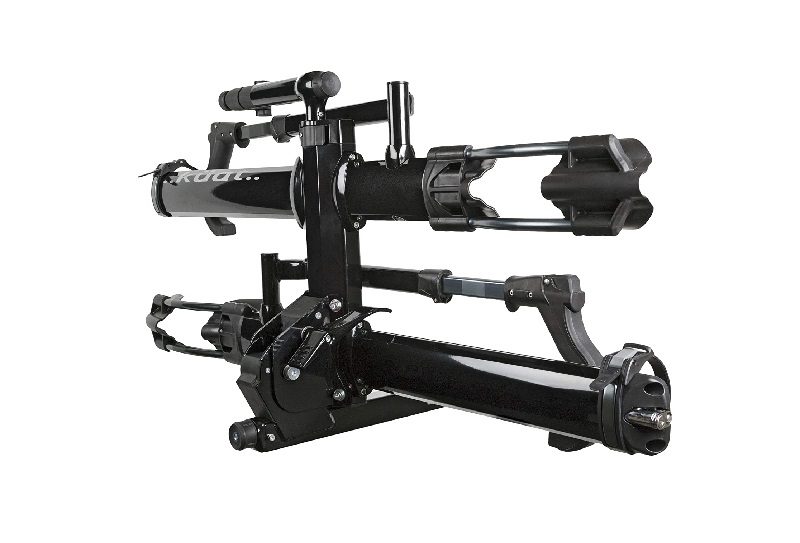
-
- Why It’s Excellent: Combines premium build quality, stylish aesthetics, and robust no-frame contact security, making it a favorite among discerning MTB riders.
- Key Specs: No-frame contact (adjustable front tire cradle system), 60 lbs/bike, fits tires up to 4.8″ (or 5″ with Phat Bike Kit), wheelbases up to 48″ (extendable). Features a foot-actuated pivot lever, integrated cable locks, and Trail Doc repair stand.
- Pros: Exceptional build quality and design, very stable, user-friendly features like foot pivot and Trail Doc.
- Cons: High-end pricing; Phat Bike Kit for widest tires is an extra.
- Best For: Riders seeking a beautifully engineered, highly stable, feature-rich, and no-frame-contact rack for their full-suspension MTBs.
- Learn More: Kuat Racks Official Site or reviews on OutdoorGearLab.
3. RockyMounts Backstage

-
- Why It’s Excellent: Unique in the premium platform category for offering a full 180-degree swing-away mechanism, providing unparalleled rear SUV access even with bikes loaded, combined with no-frame contact and robust capacity.
- Key Specs: No-frame contact (secures by front wheel), 60 lbs/bike, fits tires up to 5″ wide, wheelbases 34″-49″. Passenger-side swing, also tilts 30 degrees. 2″ hitches only.
- Pros: Game-changing 180° swing-away access, robust build, excellent for full-suspension bikes (including fat tire e-MTBs), no frame contact.
- Cons: Heavy rack (approx. 59-63 lbs), 2-bike capacity only (not expandable).
- Best For: SUV owners who prioritize maximum, unobstructed rear cargo access without compromising on a secure, no-frame-contact hold for their full-suspension bikes.
- Learn More: RockyMounts Official Site or detailed retailer pages.
4. Yakima HoldUp EVO
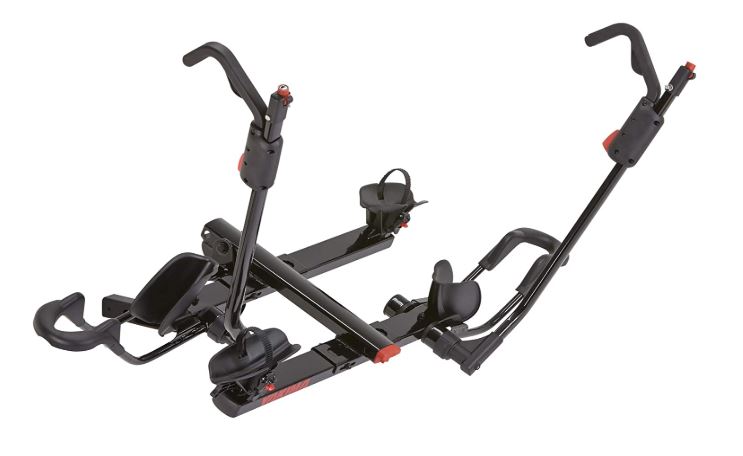
-
- Why It’s Excellent: A well-regarded platform rack featuring Yakima’s StrongArm™ wheel-securing design for no-frame contact, providing excellent protection for full-suspension and carbon frames.
- Key Specs: No-frame contact (StrongArm design secures bike at wheels), typically around 50 lbs/bike (check latest specs for e-bike compatibility if needed ), fits tires up to 4.8″ (some sources say 3.0″ for standard HoldUp, EVO is more versatile ). Tilts down with bikes loaded.
- Pros: Proven no-frame contact design, good stability, user-friendly, accommodates most full-suspension bikes.
- Cons: Tire width limitations might be a factor for some “plus” bikes compared to 5″ capacity racks; ensure the version matches your tire needs.
- Best For: Riders needing a reliable, easy-to-use, no-frame-contact platform rack from a trusted brand, suitable for a wide range of full-suspension MTBs.
- Learn More: Yakima Official Site.
5. Kuat Transfer V2
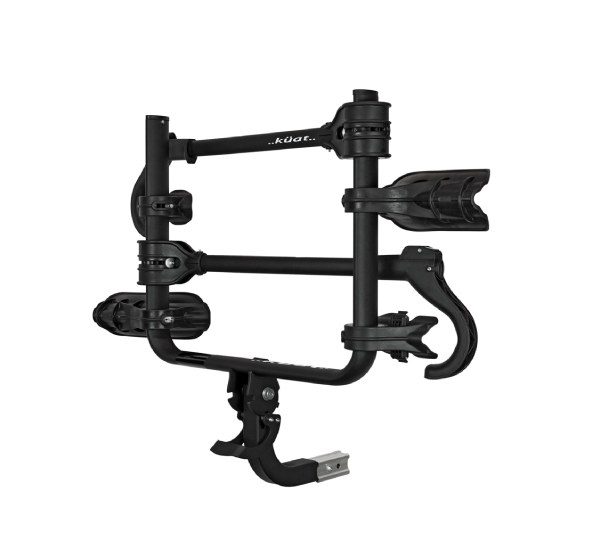
-
- Why It’s Excellent: Offers Kuat’s reputable quality and a secure no-frame contact design at a more accessible price point, making it a great value for protecting full-suspension bikes.
- Key Specs: No-frame contact (holds bikes by the tires), typically 40 lbs/bike (check specific model for e-bike considerations), fits wheel sizes 18″-29″ and tires up to 5″ wide, wheelbases up to 50″. Features a FLATLOCK cam system for stability.
- Pros: Good no-frame contact system, excellent tire and wheelbase compatibility for modern MTBs, improved stability over original Transfer, better value proposition.
- Cons: Lower per-bike weight capacity compared to some premium options, may not be ideal for very heavy e-MTBs.
- Best For: Full-suspension MTB owners seeking a reliable no-frame-contact rack that handles modern bike dimensions without the top-tier price tag.
- Learn More: Kuat Racks Official Site or retailer pages for current specs.
A Note on Other Rack Types:
- Frame Contact Platform Racks (Use with Caution): Racks like the KAC K2, Vibrelli V70, or Thule EasyFold XT use padded hooks or clamps on the frame. While often more budget-friendly or offering unique features (like EasyFold’s ramp ), be extremely cautious with carbon frames or complex suspension linkages. Ensure pads are clean and contact points are non-critical. Thule’s AcuTight knobs on the EasyFold XT help prevent over-tightening.
- Roof Racks: For those without a hitch or preferring roof transport, the Thule UpRide is an excellent no-frame contact option that secures the bike by the wheels. However, lifting full-suspension MTBs onto an SUV roof can be strenuous.
Essential Features: Choosing Your 2025 Full-Suspension MTB Rack for Your SUV
When selecting an “excellent” rack for your prized full-suspension rig, prioritize these features:
- Mounting Style: No-Frame Contact Platform is Key. Look for designs that secure the bike solely by its wheels/tires using ratcheting arms (e.g., over the front wheel), shepherd’s hooks, or secure wheel trays with straps.
- Bike Capacity & Per-Bike Weight Limit: Determine how many bikes you’ll carry and their maximum weight (consider future e-MTB upgrades).
- Tire Width & Wheel Size Compatibility: Ensure it fits your current and potential future MTB tire widths (e.g., up to 2.8″ or 3.0″ for standard MTBs, or even 5″ if you might carry fat bikes too) and common wheel sizes (26″, 27.5″, 29″).
- Wheelbase Accommodation: Check the maximum wheelbase the rack can handle (modern MTBs can exceed 48-50 inches).
- Frame Geometry Friendliness: No-frame contact designs inherently excel here, accommodating a wide variety of complex full-suspension linkages and tube shapes.
- Stability & Anti-Wobble System: A robust anti-wobble mechanism that locks the rack tightly into your SUV’s 2-inch hitch receiver is crucial.
- Ease of Loading & SUV Rear Access: Look for low loading heights and, critically for SUVs, a tilt-down or swing-away feature that allows access to your rear cargo area even with bikes mounted.
- Security: Integrated cable locks for the bikes and a locking hitch pin for the rack itself are essential.
- Durability & Build Quality: Expect high-quality materials (steel or aluminum), weather-resistant finishes, and good warranties from premium brands.

Final Thoughts for Protecting Your Full-Suspension Steed
Your full-suspension mountain bike is an investment in adventure and cutting-edge technology. Protecting its intricate frame and components during transport is paramount. For SUV owners, a high-quality, no-frame-contact platform hitch rack offers the best combination of security, stability, and ease of use. Always consider your bike’s specific weight and dimensions, your SUV’s tongue weight capacity, and prioritize features that ensure a safe and damage-free journey to the trails.
Choose your rack wisely, and enjoy the confidence of knowing your full-suspension MTB will arrive ready for action!


